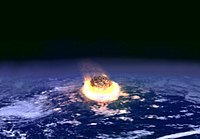
Photo from wikipedia
Abstract Fluids in geothermal reservoirs can be affected by the interaction with host rocks. To determine solute sources and water-rock interaction processes, this study collected water samples from the Upper… Click to show full abstract
Abstract Fluids in geothermal reservoirs can be affected by the interaction with host rocks. To determine solute sources and water-rock interaction processes, this study collected water samples from the Upper Cretaceous to Lower Eocene strata of the Jiangling Basin, South China. Their chemical and isotopic (hydrogen, oxygen, strontium, boron) characteristics and the mineralogy of corresponding reservoir rocks were investigated. Five high-salinity water samples (343–359 g/L) were collected from deep boreholes tapping Paleocene to Eocene formations in the central basin. Seven water samples (four oilfield and three saline waters) were collected from boreholes tapping Upper Cretaceous formations in the northwestern part of the basin and had salinities of 23.1–81.4 g/L. These water samples showed depletion of Mg and SO4 and enrichment of K, Na, Ca and Cl, compared with the ion trajectories of evaporated seawater. The observed Cl/Br mass ratios (709–1390), Na/Cl molar ratios (0.79–1.01), Ca excess and Na deficit imply contributions of halite dissolution and multiple diagenetic processes of albitization, dolomitization, and calcite and anhydrite cementation, which are consistent with the reservoir rock mineralogy. Chemical geothermometers of these geothermal fluids estimated temperatures of around 200 ± 20 °C and 125 ± 10 °C for hot brines and saline waters, respectively. Compared with the chemical compositions of Upper Cretaceous saline waters, the hot brines are enriched in K, Li, B, Sr, Rb, Cs, Br, Ba and transition metals such as Co, Ni, Cu, Zn, V, Ti and Mn. Correlations of δ18O-Li, δ18O-Rb, δ18O-Cs and δ18O-K values indicate that equilibrium with rocks caused enrichments in K, Li, Rb and Cs. Variations in 87Sr/86Sr ratios (0.706954–0.711249) and δ11B values (+8.7‰–+23.1‰) were used to find many discrepancies due to water-rock interactions involving basalt and clastic rocks. The integration of chemical and isotope data suggests that the geothermal waters in the Jianging Basin are derived from water-rock interactions and recharge of meteoric waters. In addition, the boron isotope data are consistent with traditional hydrogen, oxygen and strontium isotopes in terms of explaining water-rock interaction processes. Multi-isotopic characterization of Upper Cretaceous to Lower Eocene geothermal waters indicates that the isotopic compositions of water from the Jiangling Basin are consistent with a fluid signature of interactions involving basalt and clastic rocks with water derived from primary brine diluted by meteoric waters. The combined water chemistry and multi-isotope approach shows that high-temperature water-rock interaction is a major influence on the mineralization of hot brines in the Jiangling geothermal system.
Journal Title: Applied Geochemistry
Year Published: 2020
Link to full text (if available)
Share on Social Media: Sign Up to like & get
recommendations!